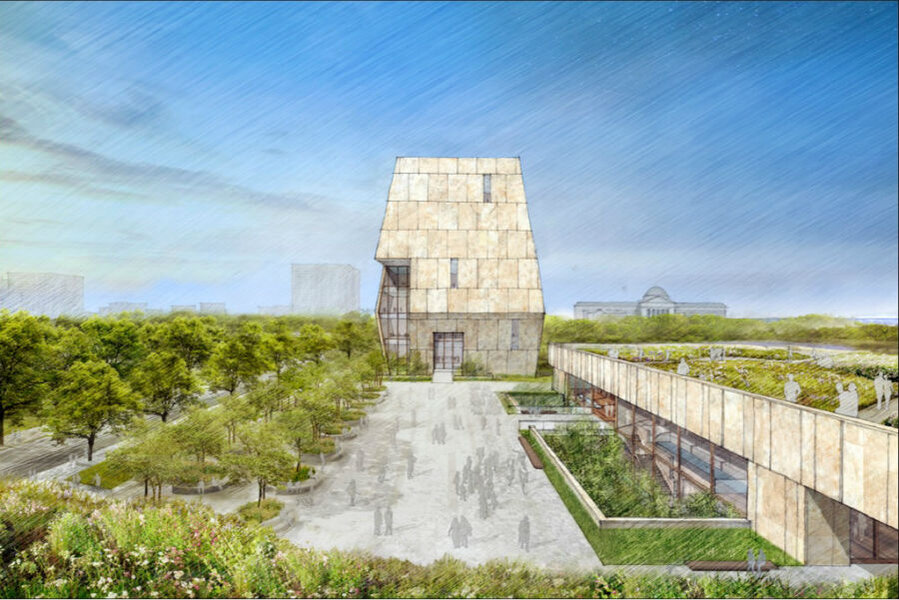Obama unveils ambitious plans for an unusual new presidential library in Chicago
Loading...
On Wednesday, former President Barack Obama announced plans for his presidential library and museum on Chicago's South Side. The Obama Presidential Center will be constructed in the northwest corner of historic Jackson Park, with a campus of three architecturally striking buildings that Mr. Obama hopes will serve as a new hub for the area where he once worked as a community organizer for low-income residents before launching his political career.
The center will include the first paperless presidential library, which will make all non-classified documents relating to his presidency available in digital form. The Lake Michigan-adjacent complex will also feature a museum, outdoor walkways, a play area, and even a community garden for schoolchildren – all components that aim to create an accessible, welcoming area for local families to gather and make their own.
It's a unique philosophy for a presidential library, a traditional institution that has been constructed for every US president since Herbert Hoover. The new complex will likely be one of the most expensive projects ever developed on Chicago's South Side, potentially revitalizing many struggling neighborhoods in the vicinity and making Jackson Park a destination rivaling even the likes of Millennium Park in the center of downtown Chicago.
"The main thing that Michelle and I contributed was just saying, 'What is it that we want to see 10 years from now?' " Obama told public officials and community leaders during the official announcement at the South Shore Cultural Center, speaking about the planning meetings with the architects of the project. "And we don't want to see some big building that's dead, and kids are getting dragged to it for a field trip. What we wanted was something that was alive, and that was a hub for the community and for the city and for the country."
The prospect of the new library and museum has excited many Chicagoans. In one public park on Chicago's North Side, responses to the news of the coming complex seem to be overwhelmingly positive.
"I'm all about it because I liked Barack Obama and thought he was a good president and I'm also all about libraries and more educational institutions," says Chicago native Colin Grimm, as he throws a Frisbee to his enthusiastic brown-speckled dog, Bodie. "I think it sounds like a good thing."
The enthusiasm for the project seems to be typical of many others in the vicinity, some of whom express a desire to visit when the campus is finished in 2021. Only two blocks away here in the North Side is a local café where Obama held one of the earliest rallies in his campaign for a US senator seat in 2004, an event commemorated in a mural along the "L" tracks at the local Red Line stop. Even though Obama was born in Honolulu, many Chicagoans feel his post-presidential legacy belongs here, in the city that launched his legal and political career.
And for Mr. Grimm, that legacy is what the new complex will represent.
"I think we need more community spaces like that, where people can gather and talk and exchange ideas, especially now more than ever," says Grimm. "I think that's a great thing."
And if the connection with the Obamas is this strong on the more affluent North Side of the city, it is even stronger on the South Side, where the Obamas' daughters were born.
"I think we really need the Obamas right now," Delois Martin, a resident of the South Side, told The New York Times. "This could give kids a place to go, and hopefully it'll help with all the violence we have here."
While most of the initial response to the new museum and library seems to be positive, there are a few dissenting voices in the mix. Chief among concerns for some residents are the large crowds and traffic the complex will bring, as well as the possibility that development in the neighborhood where the campus will be built will make the area unaffordable for many of its current residents. Some have also expressed worries that the overhaul of Jackson Park could also compromise the architectural integrity of the original park, which was designed for the World's Columbian Exposition of 1893 by famed landscape architect Frederick Law Olmsted.
But according to Obama, the new complex will offer more than the old park ever could, creating a new well of economic, cultural, and social opportunities for South Side residents.
"What we want this to be is the world premiere institution for training young people and leadership to make a difference in their communities, in their countries and in the world," said Obama.
This article contains material from the Associated Press.








